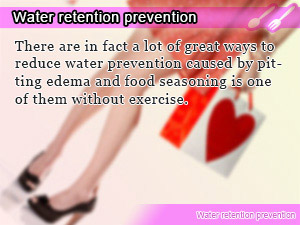It's hard to put a number on how important food seasoning is to be able to reduce water retention in your body by simply watching how you eat. Consuming to much salt in your diet is one of the major causes of leg swelling. Here are some eating tips that may help you.
Can you tell me how to reduce water retention in legs naturally?
Water retention bubbles to the surface in your face, legs, and fingers, potential slowing down your metabolism not to mention making you look fat. You may have the experience of waking up to the feeling of failing in a cosmetic experiment after looking in the mirror.
Many who have faced the horror that fluid retention has can attest that your face and thighs look bigger when you are dealing with water retention. There is just no word for it. After trying creams and detox methods with no success all that lies ahead are no more than hopeless dreams.
Keep your chin up. There is still one more thing you can try to remedy water retention before it gets out of hand. In today's Slism, we will discuss some easy to adopt eating tips that using food seasoning to smite your fluid retention worries away.
Quick eating tips on using food seasoning to remedy water retention
- Use less sugar
- More herbs and spice
- Fresh seasonal foods
- Just the right amount
- Low sodium products
- Always stick to the plan
6 Food Seasoning Eating Tips to Naturally Reduce Water Retention in Feet
In recent years in Japan the deep taste of seasoning is on the boom.
With a lot of people who would have been attracted to the words carelessly, such as eating deep-rich soup or strong tea. The words rich, dark, dark richness have charmed the masses into eating more foods that increase water retention in the body.
Eating food high in salt content is one way to develop water retention causing your legs to swell up leaving scares on the all the hard work you put into balancing your figure.
Here are a few eating tips that are easy enough to follow to reduce water retention in hard to get places like your legs and feet in no time.
1. Get your hand out of the sugar bowl
It is important to consume less the salt you have to reduce the sugar used in seasoning.
By adding excess amount of sugar or sugar-rich wines such as Mirin (a type of sweet rice wine used in cooking) you are more likely to overuse salt to make up for the flavor imbalance.
Do you have any experience of adding too much sugar only to find out that the quantity of soy sauce you add has also increased also?
In order to reduce salt, it is important to reduce sugar content, such as sugar and Mirin.
Mirin and sugar contain 35 and 46 calories, respectively. By reducing the amount of sugar and Mirin you can quickly cut down the calories in each your meals not to mention remedy water retention leaving that helps reduce leg swelling.
2. Be smart about using herbs and spice
Food seasoning such as herbs and spice for people who like to cook is often used to easily deepen to taste the taste of food in the same manner that salt is used.
By using herbs or spices as a substitute for salt you can easily reduce the salt content of your dishes without losing a sense of deepness in your cooking.
Of course, there is no excessive use of spices well, and by adding the vinegar or citrus juice or changing the way you cook your food is a good way to compensate for the dissatisfaction of taste.
3. Make good use of fresh seasonal foods
Since the taste of the foods themselves is rich, seasonal foods are eaten with good appetite, even if it does not season deeply.
Moreover, seasonal foods have high nutritive value and are economical.
Probably, it is also good to enjoy the taste of the foods themselves with fresh seasonal foods.
4. Stop estimating! Use a measuring cup and spoon
Pouring soy sauce directly out of a bottle is not a good way to know exactly how much you are using. As tempting as cooking this way is you should avoid it at all cost. Take time to focus on precision.
To prevent excessive use of condiments such as soy sauce it is important to use a measuring cup and measuring spoon whenever possible.
Just by following this simple tip you can gain a firm grasp and firmly understand for yourself how much salt you are putting in your body.
5. If it says low sodium that a sign you should use it
Have you not watched products with low sodium that indicate low salt content?
If the low-salt goods which cut down salt are used, the intake of salt can be reduced even if it uses a seasoning as usual.
Of course, just because it reduced salt products, it does not make sense that usage is increased.
Using with cautions of the amount used is important also for low-salt goods.
6. If you think there's something missing that's probably a good thing
While checking the taste of the foods you cook every once in a while there comes a point where you feel like there is something that you can add to ease the fixation of getting it just right.
It is common while tasting that you senses get the best of you resulting in a deeper dense flavor not imaginable in your first time tasting. Don't get carried away doing this. When you do all that is left is an acquired taste only appreciated by you.
Keep in mind that you can easily cut back on salt content by thinking thin. That is to say to keep the amount of food seasoning you add into cooking light.
Thinking Past Calorie Restriction Looking At How to Reduce Salt Content
Since you are serious about your diet, you don't want to let bad food seasoning turning into on obstacle keeping your from losing weight and in fact making legs look bigger than they really are due to fluid retention caused by consuming too much salt in your diet.
Although there are many people who are conscious of a calorie, there are few people who are conscious of the intake of salt.
If a refreshed leg and a sharp face line are aimed at, it will also be important to cut down salt, in order to prevent swelling.
Here is a simple table giving you a quick look at what you salt intake should be per day.
| Man | 9.0g / day |
|---|---|
| Women | 7.5g / day |
* Diet Reference Intakes for Japanese (2010)
Note that only 1/2 a tablespoon is said to contain approximately 9 grams of salt.
It is encouraged that the excessive intake of salt in your conscious and swelling in salt reduction measures.
Be conscious to excessive ingesting of salt, and would be recommended that minimize swelling with less salt.








